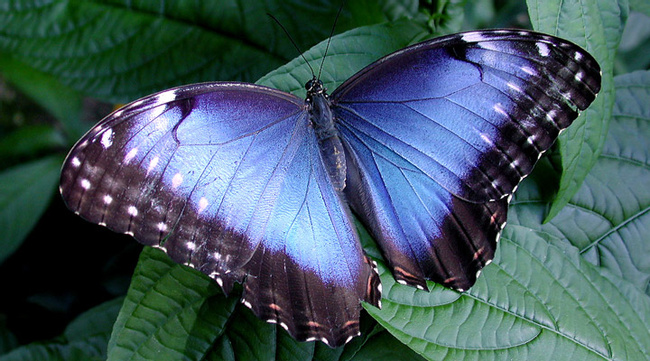
More about Blue Morpho
Habitat and range
This adaptive butterfly is most often spotted along habitat edges—of forest, field, river, or ocean. From sea level to 1,800 m in elevation, the morpho lives as far north as Mexico and as south as Venezuela, Colombia and Ecuador.
Physical Description
Visitors struggle to find words for this mesmerizing butterfly, and strive harder to catch a photo of the effulgent blue tucked inside the morpho’s wings. The morpho has a characteristic float-and-fall flight pattern, rising and dipping lazily along rivers, coastlines, forest edges, and agricultural fields. The blue upper surface of the wings interchanges with the chocolate brown underside, making the morpho difficult to track both physically and visually. This coloration strategy is referred to as “flash and dazzle” because it may cause the predator to hesitate out of confusion. When the morpho feels threatened, its flight turns erratic, looping and diving away from a pursuer. Most frustrating to the friendly photographer, the morpho keeps its wings closed when it sits on a branch or a piece of fruit. The iridescent blue may stay open longer in the sun or as the butterfly ages, but this is unpredictable.
Different species of morpho show a variety of color schemes, although most have the characteristic metallic coloration. Within the Morpho genus, adult colors range from a shocking pearly white to a lighter blue to a heavier violet shade of blue. Some species have the black border around the wings that this particular species has, but others have a paler edge color or none at all. Females are generally less colorful than the males.
Biology and Natural History
The most common butterfly in Central America, this species receives favoritism by visitors and locals alike. Morpho butterfly wings are particularly brilliant because the color is due to structure, as opposed to pigment. The wing scales are constructed so they refract light in such a way that the blue is always bright. This color does not fade. The scales can, however, get rubbed off as the butterfly ages, knocks between leaves, and narrowly misses a bird’s beak or lizard’s mouth.
For this species of morpho, males look for food earlier in the morning and females come out several hours later. Depending on the species or subspecies of morpho, the peak hours of activity may be earlier or later. Upon finding a meal of juicy rotting fruit, the morpho will feed with its wings closed. The large dark ocelli on the wing undersides will help it blend in with the surrounding forest. These ocelli resemble eyes too large for an insect, and may startle a potential predator as it approaches the morpho.
Morphos are not always bright and shiny, though. Females lay eggs on host plants that hatched caterpillars can digest. These eggs are tiny and nondescript, and the caterpillars that emerge begin eating immediately. Younger caterpillars are brown with tufts of bright red and yellow hair. By their last few molts, they are still fuzzy, but entirely brown, fat, and well camouflaged against the bark of their host plants. When it is time to pupate, the caterpillar will hang upside down from a branch, wait approximately two days, and then begin the final molt. The pupa is green and ovoid, resembling a leaf bud. After 3 weeks the butterfly emerges one morning and waits for its wings to dry before taking flight and revealing its bright blue for the first time.
Diet
As an adult, the morpho favors the juices of rotting fruit or fungal growths. As a caterpillar, it munches through leaves of host plants from the family Fabaceae, including Mucuna, Macharium, and Longchocarpus.
Height/Weight
Wingspan for a blue morpho is 20 cm.
Taxonomy
Order: Lepidoptera
Family: Nymphalidae
Sources
DeVries, Philip J. The Butterflies of Costa Rica and Their Natural History: Papilionidae, Pieridae and Nymphalidae. Princeton, NJ: Princeton University Press, 1987.
Goode, Mark R. An Introduction to Costa Rican Butterflies. San José, Costa Rica. 1999. ISBN 9977-12-365-9.
Hogue, Charles L. Latin American Insects and Entomology. University of California Press: Berkely and Los Angeles, 1993.
Kricher, John. A Neotropical Companion: an introduction to the animals, plants, and ecosystems of the New World tropics. Princeton University Press: Princeton, NJ, 1997.
-Amy Strieter, Wildlife Writer
Similar Profiles
It's more than just having a good time or visiting beautiful places (although that's absolutely a part of it!), it's about being part of a unique experience that stays with you.



